The Amazons frequently pop up in Greek mythology. But unlike the demi-god Hercules, they were probably real.

Carole Raddato/Louvre Museum/Wikimedia CommonsAn Amazon on horseback is seized by a Greek opponent in this fourth-century mosaic from Daphne, Turkey
Legends of formidable female warriors known as the Amazons permeate ancient lore – and, with the Wonder Woman franchise, modern-day movie screens. In particular, Ancient Greek writers loved spinning tales of how the Amazon women matched men in their traditional domain of war-making.
Mythographer Apollodorus, writing in the first or second century A.D., dubbed the Amazons “a people great in war,” who were so committed to martial endeavors that they “pinched off the right breasts that they might not be trammelled by them in throwing the javelin, but they kept the left breasts, that [their offspring] might suckle.”
They were even said to challenge the likes of such mythological warriors as Heracles, Theseus, and Achilles. But were the Amazons just a myth — or were they real?
The Real Amazons Of Ancient History
What did the ancient Greeks have to say about the Amazons outside of myths? As classicist Adrienne Mayor noted in her seminal book, The Amazons, apparently, they believed that the Amazons were very much real historical figures. They may have very well been real-life horse-riding women hailing from Western Asia — places such as Iran and the Caucasus — who fought valiantly against their enemies.
According to Smithsonian Magazine, Homer’s Iliad was the first to mention them in the eighth century B.C. He described them as “antianeirai,” which many scholars have translated as “the opposite of men,” “antagonistic to men,” and “the equal of men.”
Centuries later, the so-called “Father of History,” Herodotus, wrote that the Amazons hailed from Scythia, a large steppe region in Central Eurasia.
Dubbed “man-killers” in the Greek tongue, the Amazons lived an idyllic, isolated existence, only mingling with men from neighboring tribes once a year in a ceremonious procreation ritual. The mothers would keep their female offspring and train them as warriors, and send off their male infants.
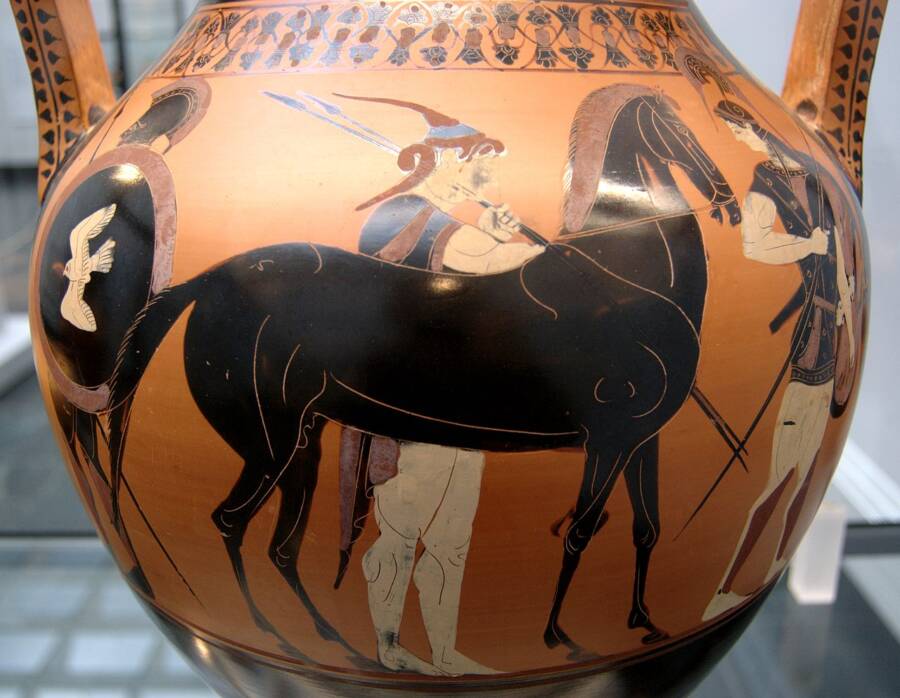
Bibi Saint-Pol/
Staatliche Antikensammlungen /Wikimedia CommonsAmazons riding out to help the Trojans on a 6th-century BC amphora.
But their all-female utopia came to an end in the Battle of Thermodon, when three Amazonian ships sailing through the Black Sea reached the shores of Scythia. The native men and Amazonian women soon fell in love, marrying and starting their own tribe distinguished by revolutionary gender equality.
According to Herodotus, the Amazons “could not dwell with [the Scythian] women; for we and they have not the same customs. We shoot with the bow and throw the javelin and ride, but the crafts of women we have never learned.”
Herodotus called the descendants of these marriages the Sauromatae, or Sarmatians. Writing in the fifth century B.C., he said “the women of the Sauromatae have continued from that day to the present to observe their ancient customs, frequently hunting on horseback with their husbands…in war taking the field and wearing the very same dress as the men….Their marriage law lays it down, that no girl shall wed until she has killed a man in battle.”
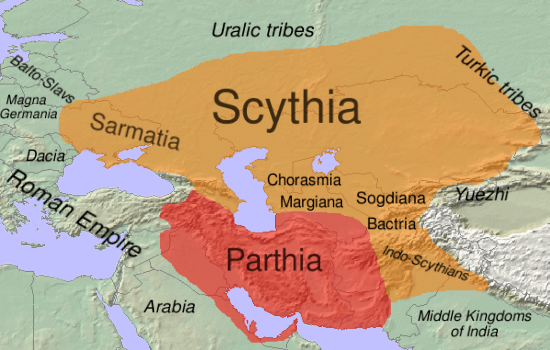
Dbachmann/Wikimedia CommonsA map of ancient Scythia, where the historical Amazons are believed to have lived.
Amazons In Myth
In Greek mythology, the Amazons were fearsome adversaries to the greatest heroes of the day. Theseus, the slayer of the Minotaur, and Heracles, known in Ancient Rome and in the West as Hercules, were both said to have battled the Amazons.
In Theseus’s case, he reportedly ran off with the Amazons’ queen. Plutarch, writing in the beginning of the first millennium, calls the queen Antiope, though other ancient writers identify her as Hippolyta, Antiope’s sister.
By varying accounts, Theseus either stole the queen, had Heracles steal her for him, or the queen fell in love with Theseus and willingly left with him on his ship.
Furious, the Amazons trekked all the way to Athens to liberate their ruler. According to Plutarch, they put up a good fight: “The war of the Amazons…[was] no trivial nor womanish enterprise for Theseus. For they would not have pitched their camp within the city, nor fought hand to hand battles in the neighborhood of the Pnyx and the Museum, had they not mastered the surrounding country and approached the city with impunity.”
It was only after the Attic War, a hard-fought, three-month-long battle, which culminated in the death of their beloved leader, that the Amazons retreated. So many Amazon warriors died valiantly at Athens that they were buried at near a site called the Amazoneum, a temple that stood during Plutarch’s time and that may have been where Ancient Greeks would go to worship the mythic Amazons.
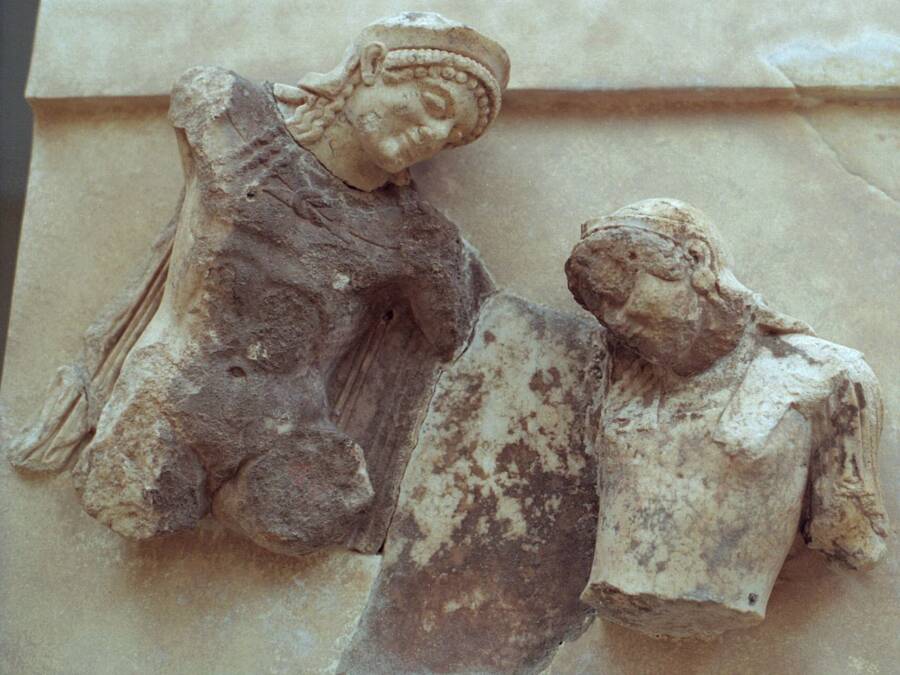
Zde/Archaeological Museum of DelphiTheseusand Antiope, as pictured on the Treasury of Athenians at Delphi, from 500 BC.
Theseus and the Amazon queen’s relationship was famous for yielding a son, Hippolytus. According to one interpretation, he was devoted to the goddess of the hunt, Artemis, and defied Aphrodite, the goddess of love.
In retaliation, Aphrodite cursed his stepmother Queen Phaedra of Athens — the second wife of Theseus — making her fall in love with Hippolytus. However, Hippolytus rejected her advances, leading to his death and Phaedra’s suicide.
Heracles And Hippolyta’s Girdle
Another major Amazon adventure came when Heracles embarked on his ninth quest: retrieving the famous girdle of the Amazon Queen Hippolyta for Eurystheus, the daughter of a Mycenaean king. According to myth, this magical girdle was a gift from Hippolyta’s father, Ares, the god of war.
When Heracles landed at Themiscyra, the legendary capital of the Amazons situated on the northern coast of present-day Turkey, Hippolyta was happy to receive him and promised to give him the girdle. But his stepmother, Hera, transformed herself into a mortal Amazon warrior and went around “saying that the strangers who had arrived were carrying off the queen.”
To protect her, the Amazons charged the Greek hero, who “suspected treachery” and killed Hippolyta for the girdle, setting off for Troy.
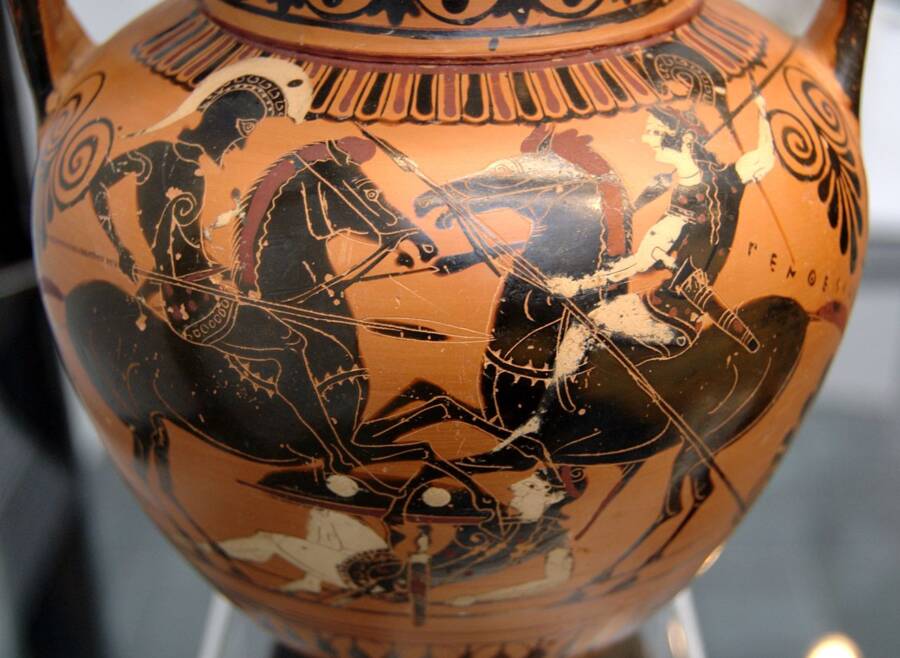
Bibi Saint-Pol/Wikimedia CommonsAchilles and Penthesilea, queen of the Amazons, fight on a 6th-century B.C. amphora.
According to historian Diodorus Siculus, who lived in the first century B.C., Heracles slayed so many Amazons during his quest that this gave neighboring barbarian tribes an opportunity to attack them.
The Amazons In The Trojan War
A few generations later, by the time of the Trojan War, there were only a few Amazon warriors left. Led by Queen Penthesilea, they allied themselves with the Trojans against the Greeks, who were led by the Ethiopian King Memnon, Spartan King Menelaus and the demigod Achilles, the greatest of the Greek mythological warriors.

Franz von Matsch/Wikimedia CommonsThe ancient Greek war hero Achilles was said to have fallen in love with an Amazonian during the Trojan War.
It is said that “after the death of Hector she [Penthesilea] slew many of the Greeks.” And the only warrior who could match her prowess was the mighty Achilles himself.
A surviving synopsis from a lost ancient epic, the Aethiopis, recalls that Achilles only defeated her after she displayed “great prowess” on the battlefield.
So enchanted by her beauty and martial skills was Achilles that one of his fellow warriors, Thersites, mocked him for his affections. Angry, Achilles slew Thersites for his rudeness.
After Penthesilea’s death, the Amazons dwindled even further.
Historian Siculus lamented: “Now they say that Penthesilea was the last of the Amazons to win distinction for bravery and that for the future the race diminished more and more and then lost all its strength; consequently in later times, whenever any writers recount their prowess, men consider the ancient stories about the Amazons to be fictitious tales.”
Did Alexander The Great Have A Child With An Amazon?
The Amazons are also mentioned in the writings of Plutarch. In his Lives, Plutarch recounted Alexander the Great’s march into Parthia, or present-day Iran, in the fourth century B.C.
While he was recovering from diarrhea, legend has it, the queen of the Amazons came to visit Alexander in order to breed a new race of super-strong and intelligent children — although Plutarch himself was doubtful this ever happened.
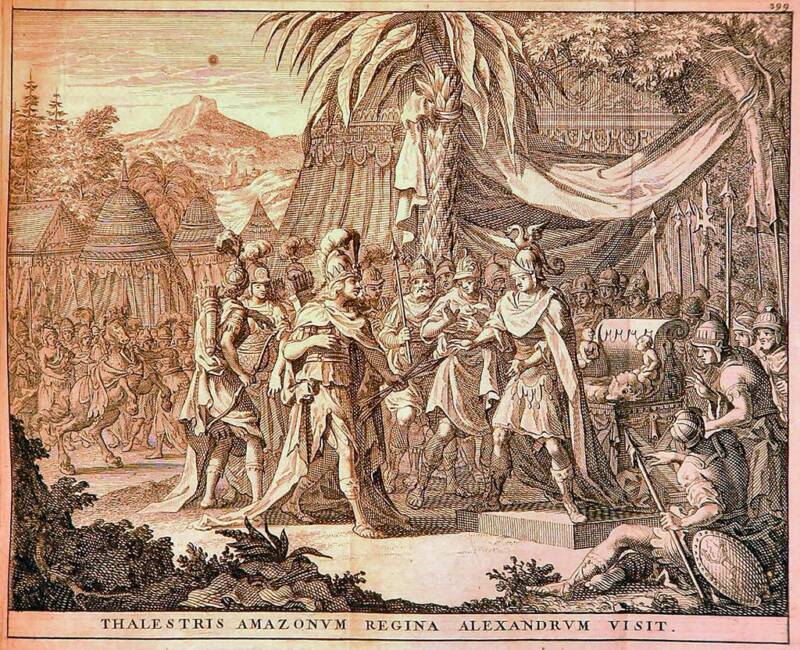
AlexandersTomb.com/Wikimedia CommonsThe Amazonian queen Thalestris meets Alexander the Great.
Later historians such as Diodorus Siculus stated that Thalestris, queen of the Amazons, paid Alexander a visit. He described her as “remarkable for beauty and for bodily strength, and was admired by her countrywomen for bravery.”
Along with 300 of her Amazon women, Thalestris came to Alexander to conceive a child because “he had shown himself the greatest of all men in his achievements, and she was superior to all women in strength and courage, so that presumably the offspring of such outstanding parents would surpass all other mortals in excellence.”
Diodorus said Alexander was happy to oblige, and after nearly two weeks of sex, sent Thalestris home with presents — and presumably an heir.
Archaeological Evidence For The Amazons

Joanbanjo/Wikimedia CommonsA gold vessel from a burial site of real-life warrior women.
In recent decades, archaeologists have excavated grave sites in Western Asia and Russia, unearthing proof that women fitting the description of Amazons may have very well existed.
In what was considered the homelands of the historical Amazon women, scientists have uncovered burial places of women with lavish grave goods that indicated not only their wealth but, more importantly, their warrior status.
As summarized by Mayor:
“Archaeologists have found skeletons buried with bows and arrows and quivers and spears and horses. At first they assumed that anyone buried with weapons in that region must have been a male warrior. But with the advent of DNA testing and other bioarchaeological scientific analysis, they’ve found that about one-third of all Scythian women are buried with weapons and have war injuries just like the men. The women were also buried with knives and daggers and tools. So burial with masculine-seeming grave goods is no longer taken as an indicator of a male warrior. It’s overwhelming proof that there were women answering to the description of the ancient Amazons.”
More evidence came in the 1990s, when archaeologists excavated burial mounds of ancient women in the former Soviet bloc. These graves contained not only rich ornamentation but also weapons.

Marcel NyffeneggerThe recreated visage of a teenage Amazon warrior woman, found in a burial site in Siberia. Archaeologists believe she lived about 2,500 years ago.
Then, in Kazakhstan, archaeologist Jeannine Davis-Kimball uncovered deceased women who were bow-legged from a lifetime of riding horses, while another woman was buried with 40 arrows tipped in bronze.
As Davis-Kimball told The New York Times in 1997: “These women were warriors of some sort. They were not necessarily fighting battles all the time, like a Genghis Khan, but protecting their herds and grazing territory when they had to. If they had been fighting all the time, more of the skeletons would show signs of violent deaths.”
Why Were The Greeks So Fascinated By The Amazons?
Even if the Amazons were indeed real, it seems the ancient Greeks used Amazon myths to put women in their place.
In the words of one ancient Greece expert, every Amazon myth followed the same “dark mythic script: all Amazons must die, no matter how attractive, no matter how heroic.” The Greeks may have toyed with the possibility that women were the equals of men, but ultimately erred on the side of subjugation.
While their mythological portrayal is somewhat exaggerated — most notably, their supposed tendency to live in a female-only or female-dominated society — warrior women who rode into combat alongside men certainly existed in the steppes of Eurasia, inspiring the Greeks to write enthralling stories of their beauty and martial prowess.
Little did they know, those stories would inspire and entertain more than 2,000 years later.
After reading about the Amazon women of ancient Greek myth — and reality — read about another formidable woman from antiquity, the ruthless Empress Wu Zetian of China. Then, learn all about ancient societies that adopted pederasty.






